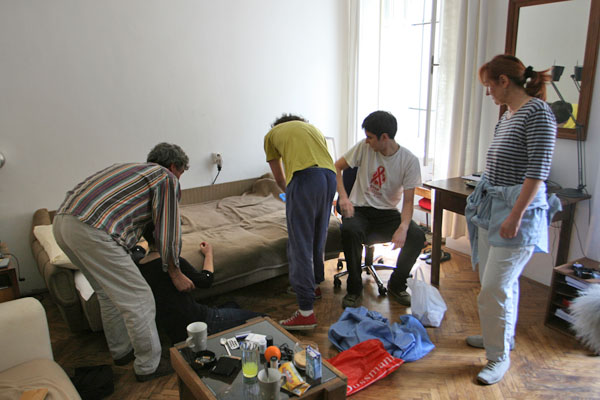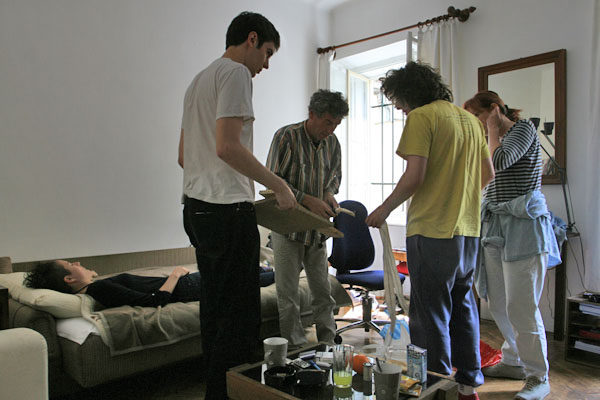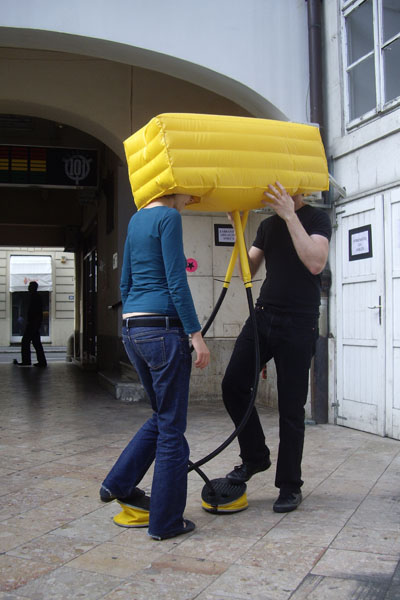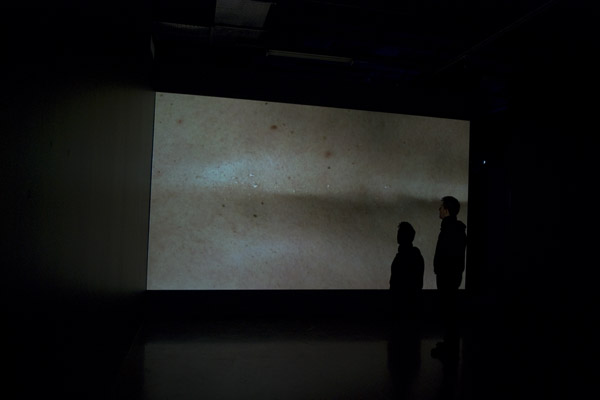Random Entrant Performance Studies International (PSi15) Zagreb (2009)
Alicia Frankovich’s ‘I would like to be attached to a random entrant to the performance viewings’ (2009)
David Cross’ ‘Pump’ (2009)
Christopher Braddock, Back (2008), looped dvd 59.54 minutes
In June 2009 Alicia Frankovich, David Cross and Chris Braddock performed and exhibited “Random Entrant” for the fifteenth PSi (Performance Studies International) conference ‘MISPERFORMANCE: Misfiring, Misfitting, Misreading’ in Zagreb (Chris Braddock as curator). They were joined by theatre and performance scholar Joe Kelleher from Roehampton University in the UK in giving individual conference papers in the Panel “Are You Partial”. Chris Braddock also authored an essay on the project entitled “Random Entrant and the Force of Failure” for the Frakcija Performing Arts Journal, 50(Spring), 26-33.
Alicia Frankovich’s ‘I would like to be attached to a random entrant to the performance viewings’ (2009)
Alicia Frankovich (as her titles denotes) would like to be attached to a random entrant to the performance viewings. This performance may begin from when the chosen viewer leaves their house or job to travel home or to their next location. Attached to a mat or board of some kind, Frankovich performs in accordance with, and at the mercy of, the viewer: she is mobile, but attached. Pertaining to the non-event, this performance critiques the spectacle and, in a way, passes on a responsibility to perform onto the viewer. The role of the artist is handballed to the viewer. Frankovich would require that the viewer be ‘amateur’ (she prefers a non artist to be selected) and prepared to enter the stage toward the end of the performance. In this way the piece both escapes and embraces failure, misbehaviour and misperformance. It sets itself up for failure in and with a non-performer. The idea of ‘presentation’ is taken, and twisted, in an embodied activation of the space of the audience, the wider ‘stage’ and the artist.
Alicia Frankovich was born in 1980 in Tauranga, New Zealand and lives and works in Berlin and Melbourne. She graduated in 2002 with a Bachelor of Visual Arts (Sculpture) at Auckland University of Technology. She was a studio artist at Gertrude Contemporary Art Spaces, Melbourne, (2005-6) and recently undertook residencies at the Fire Station in Dublin (2008), and at Fondazione Antonio Ratti on Lake Como with Joan Jonas (2007). This year she received an award at The International Prize for Performance, Galleria Civica di Arte Contemporanea, Trento, Italy. She is included in Ice Cream, Contemporary Art and Culture by Phaidon Press (2007). Her next project is a one-night event called SEMPRE MENO, SEMPRE PEGGIO, SEMPRE PIÙ at Le Case d’Arte Milano, November 2008.
David Cross’ ‘Pump’ (2009)
‘Pump’ is a performance that will examine the notion of diminished sensory capacity. Working with an inflated body attachment that significantly hinders coherent visual, aural and cognitive orientation, the artist will attempt to navigate his way around the performance space filled with spectator/participants. The monochromatic object appears as a strange amalgam of forms including vinyl inflated structure and organic prosthetic growth. The audiences’ role in the work is crucial: having to decide how to help, hinder or avoid the artist over the performance duration. ‘Pump’ will last as long as it takes the artist to find a way out of the space and into the light outside. ‘Pump’ continues Cross’ examination of the partial body/partial object. The work also examines performance as an ordeal that mixes recreation and pleasure with an examination of psychic and sensory limits.
David Cross has exhibited widely across New Zealand, Australia and Eastern Europe. His work was selected for inclusion in Perspecta 99 at Performance Space in Sydney and the Australian Centre for Contemporary Art, Melbourne. A major performance project was developed for the leading performance festival Interactions 5 in Poland (2003). More recently his work was included in Play: Performance and Portraiture in Australian and New Zealand Performance Art. His work ‘Bounce’ was part of the critically acclaimed performance series Mostly Harmless at the Govett Brewster Art Gallery, New Plymouth (2006). His enormous performance installation ‘Hold’ has been shown across New Zealand to critical acclaim. He is well known for his often confrontational and challenging performances that place particular emphasis on the audience as collaborators. He is Associate Professor in Fine Arts at Massey University and Director of the Litmus Research Initiative.
Christopher Braddock’s ‘Back’ (2008)
(looped dvd, 59.54 minutes)
For ‘Back’ Braddock filmed himself naked and close-up from behind in a blackout studio doing an activity that is never fully disclosed. The object that he manipulates is never seen and the views of his body are partial. He contorts, bending over, grappling with some form or other between his knees. ‘Back’ is filmed vertically (locating his body’s vertical axis as it moves up and down), but projected horizontally so that the image of his body scrolls in and out of the viewer’s space (not literally linked to their vertical axis). His body moves in and out of frame so that the body/s of the audience are often on their own in darkness while the sound of his efforts continue. The sound track, consisting of breathing and slapping, accentuates the energy and doing of the process as well as a sense of ambivalence about what kind of activity might be taking place. The work is projected larger than life-size to increase an experience that is ‘embodied’ as the projected image overwhelms the space in which viewers stand. This work indexes the ‘body of the artist’ at work (always in a process of performative utterance underscored by the incessant sound-track of breathing and slapping). Many of the ‘performances’ Braddock undertakes are privately filmed where his body becomes a part object (always partially viewed), and where his ‘making’ is forever futile, misleading, and repeated in the digital loop. His audiences often experience misleading dislocations from the images and audio components.
Christopher Braddock’s recent moving image and sound installation entitled ‘The Artist Will Be Present’ (2008) at St Paul St, Auckland, positions the body of the artist always one-step-removed from the audience as both ‘documentation’ and the event itself. His artist-in-residence project at Melbourne’s RMIT University (2007) tested modes of audience participation with part-sculptural objects moulded off the artist’s body and where viewers were invited to handle the objects under video surveillance. By these operations Braddock seeks out an expanded notion of the ‘live’ encounter. In this sense a kind of misperformance problematises the ‘live’ by never offering up the ‘presence’ of his body.
Are You Partial
Panel proposal for Performance Studies International (PSi15) Zagreb 2009
Our aim is to approach different modes of performance and performative installation from the perspective of redundancy: what is left out, left private, overlooked, unidentifiable, masked from view or too mimetically close. We aim to complicate and frustrate a tendency to assume a possible wholeness, in both bodies and their representation, either in live art/theatre or the performance document.
This panel examines modes of partiality (part subjects and objects) as they operate from a position of lack. Our focus lies particularly with the performer’s/artist’s body in relation to the body/s of the audience. We are interested in performers/artists and theorists who insist that rituals of ‘live’ performance, as well as objects/documents that stem from live action, simultaneously solicit and frustrate a desire for completion in the body/s of the audience. From this viewpoint it is precisely the dysfunctionality of these part bodies (ambiguously part subjects/objects) that lends them force. We proffer haptic, somatic bodies in process, always undefinable and on the move. We understand a possible failure or ‘misperformance’ of performance rituals as what lends them efficacy.
A mix of artists/theorists offer this panel first-hand ‘practitioner’ insights into how performers/artists employ their bodies, together with articulate discussions that contextualise those operations in the fields of art history, performance studies and anthropology.
In précis, this panel articulates a notion of a force-field of redundancy that performatively draws out audiences as they desire closure both in object and duration. This is the force of the partial that questions the ethical and aesthetic consequences of the operations of scopic representation, longevity and permanent collection.
Moving parts: on indifference
Joe Kelleher
The paper is concerned with effects of partiality and indifference in theatricalised performance. It is, in part, informed by philosopher Quentin Meillassoux’s reflections on a world that ‘we can henceforth conceive of as indifferent to everything in it that corresponds to the concrete, organic connection that we forge with it’, a world ‘more indifferent than ever to human existence, and hence indifferent to whatever knowledge humanity might have of it.’ The focus, however, will not be on worlds but on parts, perhaps the slightest of parts: elements of performance that appear to exhibit such indifference even while they remain with us, moving still, to trouble our thought long after the performance is over. The discussion will focus on work such as the deadpan polemics of transvestite performer Ane Lan, work made up of minimally moving parts, which draws towards it not so much our thought as our thoughtlessness, and – it may be – suffers what that thoughtlessness brings. If the spectacle would appear at times to be one of weak performance, barely strong enough to engage the full force of our thinking, it is a performance that will also still be standing there, with its speechless demand, after our thinking (whatever that was worth) has played itself out.
Forms of Assistance
Alicia Frankovich
This paper expands my ‘Shift’ performance, describing my body as a ‘raw’ material, used as a sculptural material. I will discuss a kind of performing body that is activated by physical and spatial transfer, employing sculptural appendages as a means by which to manifest energy and movement. I will raise the question (or problematic) of performance documents and their materiality as by-products or extensions of performance. This paper itself – as an aftermath of my performance – extends the phenomenon of the post–performance object. This will extend to a written account (that functions as an art work) of my performance, which involves a ‘lame journey’ and ‘impromptu arrival’. These operations raise questions such as: ‘In what way should the viewer receive a work when it is not conceivable for them to be present for the duration of the performance?’ or ‘How might the viewer see the work outside of the live undertaking?’ Notions of lack of control, lack of product, lack of spectatorship, or a ‘misfiring’ of my (non) spectacle will be discussed. Failure (and the art values of skill and production) is a concept that I will bring to the fore where art-outsiders are called upon to participate in my work as both makers and vehicles for production and performance. Here ideas of ‘the stage’ and the grandiose are interrogated, pushing forward a politic of an expanded field: a more fluid public and personal domain or performance.
Partial Bodies, Partial Objects:
the necessity of hybridised performance
David Cross
This paper interrogates Marina Abramovic’s position that the future of performance is based on its ability to transcend an engagement with objects and operate as a discrete discipline in its own right. Such an idea, redolent with a coherent disciplinarity, runs counter to the modalities of art in the post-medium condition. My paper will examine relationships between the body and object in contemporary performance with reference to the idea of the object as filter, or blind spot, that does not diminish but rather serves to enhance and unfold a fuller understanding of corporeality. The partial use of objects in tandem with the partial manipulation/representation of the body, offers a litany of possibilities for drawing audiences into new understandings of liveness that are compelling precisely because the body is not made coherent or complete. Working with a number of case studies, including Paul McCarthy and two of my own recent performance/installations, I locate a hybrid category of performance/installation as a critical and evolving modality by which audiences might come to rethink what and how they know the live body.
Sympathetic Mimesis and the Force of Failure
Christopher Braddock
The paper explores performance and part-sculptural ‘objects out of action’ via the histories and practices of sympathetic magic. Revealing the manners in which various rituals act to animate objects, I focus on notions of mimesis, similitude and contagion. British anthropologist Stanley J. Tambiah’s thinking on persuasive analogy in ritual performance draws a crucial link between J. L. Austin’s performative utterance and James George Frazer’s notion of sympathetic magic. Applied to contemporary debates on performance and ‘objects out of action’, these part objects act as partial ‘subjects’ that are unlocatable as trace (substitution) and contagious contact (liveness). What is lacking in the operations of sympathetic mimesis is precisely what ‘draws out’ the body/s of the audience. Put another way, redundancy is viewed as necessary to an efficacious or ethical practice. This paper will include my own recent performative/video and sound installations as well as exploring the Euro-American genealogies of performance / body art in relationship to contemporary art practices in Australia and New Zealand (Alicia Frankovich, Carolyn Eskdale et al.).



